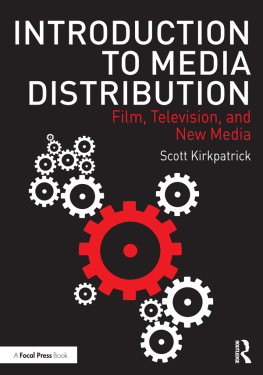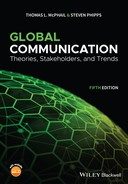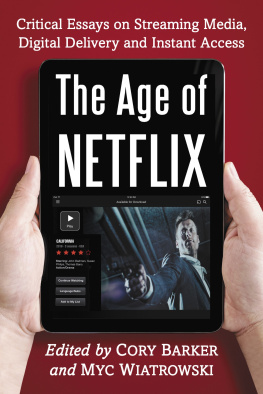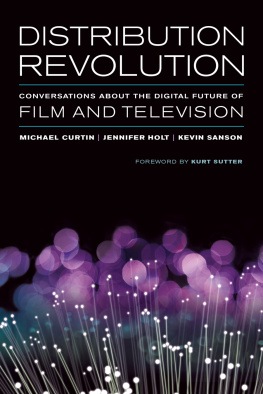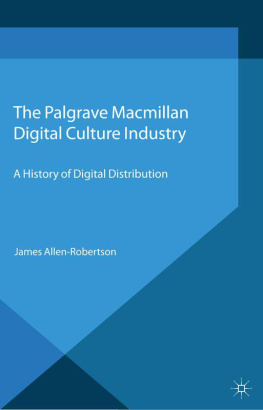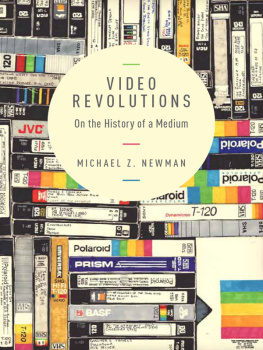ABOUT THE AUTHOR
Ramon Lobato is Senior Research Fellow in Media and Communication at RMIT University, Melbourne. His previous books include Shadow Economies of Cinema , The Informal Media Economy , and Geoblocking and Global Video Culture .
ACKNOWLEDGMENTS
Like any television program, digitally distributed or otherwise, this book would not exist without the contributions of a great many people. Between 2015 and 2017, I was fortunate to receive an Australian Research Council Discovery Early Career Researcher Award (DE150100288), which allowed me to spend much of my time conducting research for this book and its companion volume Geoblocking and Global Video Culture (2016), which I coedited with James Meese. Over the course of this fellowship, I was lucky enough to work with a number of very talented scholarsAlexandra Heller-Nicholas, James Meese, Tessa Dwyer, Alexa Scarlata, Ben Morgan, Chris Baumann, Thomas Baudinette, Wilfred Wang, Ishita Tiwary, and Renee Wrightwho provided research assistance as well as countless critical conversations. Briefing papers written by Thomas, Wilfred, Ishita, and Renee were especially important for . Naturally, I am also grateful to the Australian Research Council for making this research possible. Jonathan Gray, whose knowledge of television knows no boundaries, provided encouragement and advice over several years as this project took shape, and kindly hosted a visit to the University of Wisconsin-Madison in 2017, where I was able to try out some ideas that would make their way into this book. Amanda Lotz has been a generous interlocutor throughout and has helped me see this topic in entirely new ways. Colleagues in the Global Internet Television Consortium provided a forum for comparative insight. Julian Thomas, Jennifer Holt, Hannah Withers, Patrick Vonderau, Stuart Cunningham, Joshua Braun, Scott Ewing (greatly missed), Jock Given, Tom ORegan, Ellie Rennie, Rowan Wilken, Csar Albarrn-Torres, Dan Golding, Liam Burke, Jenny Kennedy, Esther Milne, and Aneta Podkalicka, among others, offered sage advice, support, and help with translations. I am also grateful to audiences at the Porting Media conference (Concordia University, October 2017), the Cultural Studies Association of Australia, and the International Communication Association conferences where various drafts of this work were presented. Finally, thank you to Eric Zinner and Dolma Ombadykow at New York University Press; Critical Cultural Communication series editors Aswin Punathambekar, Adrienne Shaw, and Jonathan Gray (again); and two reviewers who provided careful and constructive feedback.
This book draws on some ideas and material that were initially developed in the earlier publications Geoblocking and Global Video Culture (2016); Rethinking International TV Flows Research in the Age of Netflix (2017); The Friction of Digital Markets (2017); and Streaming Services and the Changing Global Geography of Television, in Handbook on Geographies of Technology , edited by Barney Warf (2017).
BIBLIOGRAPHY
Abbate, Janet. 1999. Inventing the Internet . Cambridge, MA: MIT Press.
Aglionby, John, and Matthew Garrahan. 2016. Kenya Threatens to Ban Netflix over Inappropriate Content. Financial Times , January 21. www.ft.com/content/9e97edf0-bf7111e5846f-79b0e3d20eaf.
Alexander, Neta. 2016. Catered to Your Future Self: Netflixs Predictive Personalization and the Mathematization of Taste. In The Netflix Effect: Technology and Entertainment in the Twenty-First Century , edited by Kevin McDonald and Daniel Smith-Rowsey, 8197. New York: Bloomsbury Academic.
Amatriain, Xavier, and Justin Basilico. 2013. System Architectures for Personalization and Recommendation. Netflix Tech Blog , March 27. techblog.netflix.com/2013/03/system-architectures-for.html.
Anderson, John. 2016. An Over-the-Top Exemption: Its Time to Fairly Tax and Regulate the New Internet Media Services . Report. Ottawa: Canadian Centre for Policy Alternatives.
Associated Press. 2004. Geolocation Tech Slices, Dices World Wide Web. Augusta Chronicle , July 12. chronicle.augusta.com/stories/2004/07/12/liv_421904.shtml.
Australian House of Representatives Standing Committee on Infrastructure and Communications. 2013. At What Cost? IT Pricing and the Australia Tax . Report.
Avari, Jamshed. 2016. Netflix Is Here, and No, It Is Not Censoring Any Content. Gadets360 , January 7. gadgets.ndtv.com/tv/features/netflix-is-here-and-no-it-is-not-censoring-any-content-786669.
Banks, Jack. 1997. Monopoly Television: MTVs Quest to Control the Music . Boulder, CO: Westview Press.
Barker, Chris. 1997. Global Television: An Introduction . Malden, MA: Blackwell.
Beer, David. 2013. Popular Culture and New Media: The Politics of Circulation . New York: Palgrave Macmillan.
Beirne, Rebecca. 2015. Piracy, Geoblocking, and Australian Access to Niche Independent Cinema. Popular Communication 13 (1): 1831.
Bennett, James. 2011. Introduction: Television as Digital Media. In Television as Digital Media , edited by James Bennett and Nikki Strange, 127. Durham, NC: Duke University Press.
Bennett, James, and Nikki Strange, eds. 2011. Television as Digital Media . Durham, NC: Duke University Press.
Blakley, Johanna. 2016. Technologies of Taste. IEEE Technology and Society Magazine , December, 3943.
Blaney, Martin. 2013. Netflix Open to Euro Investment. Screen International , November 22. www.screendaily.com/news/netflix-open-to-euro-investment/5063919.article.
Block, Alex Ben. 2012. Netflixs Ted Sarandos Explains Original Content Strategy. Hollywood Reporter , April 7. www.hollywoodreporter.com/news/netflix-ted-sarandos-original-content-309275.
Blum, Andrew. 2012. Tubes: A Journey to the Center of the Internet . New York: Ecco.
Boddy, William. 2004. Interactive Television and Advertising Form in Contemporary U.S. Television. In Television after TV: Essays on a Medium in Transition , edited by Lynn Spigel and Jan Olsson, 113132. Durham, NC: Duke University Press.
Bttger, Timm, Felix Cuadrado, Gareth Tyson, Ignacio Castro, and Steve Uhlig. 2016. Open Connect Everywhere: A Glimpse at the Internet Ecosystem through the Lens of the Netflix CDN. arXiv Working Paper. eecs.qmul.ac.uk/~boettget/mapping-netflix-coseners16.pdf.
Bogost, Ian, and Nick Montfort. 2009a. New Media as Material Constraint: An Introduction to Platform Studies. Paper read at the 1st International HASTAC Conference, at Duke University, Durham, NC. bogost.com/downloads/Bogost%20Montfort%20HASTAC.pdf.
________ . 2009b. Platform Studies: Frequently Questioned Answers. In Proceedings of the Digital Arts and Culture Conference 2009 , University of California-Irvine, December 14, 2009. pdf.textfiles.com/academics/bogost_montfort_dac_2009.pdf.
Borenstein, Eliot. 2016. No Netflix, No Chill: In Russia, Its Better to Purge than to Binge. Huffington Post , n.d. www.huffingtonpost.com/entry/no-netflix-no-chill-in-ru_b_10636080.html.
Boyd, Danah, and Kate Crawford. 2012. Critical Questions for Big Data. Information , Communication and Society 15 (5): 662679.
Braun, Joshua. 2013. Going Over the Top: Online Television Distribution as Sociotechnical System. Communication , Culture and Critique 6 (3): 432458.
________ . 2015. This Program Is Brought to You by Distributing Television News Online . New Haven, CT: Yale University Press.
Brodkin, Jon. 2016. Netflix Asks FCC to Declare Data Caps Unreasonable. Ars Technica , September 13. arstechnica.com /information-technology/2016/09/netflix-asks-fcc-to-declare -data-caps-unreasonable/.
Brooker, Will. 2001. Living on Dawsons Creek : Teen Viewers, Cultural Convergence, and Television Overflow. International Journal of Cultural Studies 4 (4): 456472.
Buonanno, Milly. 2007. The Age of Television: Experiences and Theories . Bristol: Intellect.
Burgess, Jean, and Nancy Baym. 2016. @RT#: Towards a Platform Biography of Twitter. In Platform Studies: The Rules of Engagement , 911. Selected papers of AoIR 2016: The 17th Annual Conference of the Association of Internet Researchers, Berlin, October 58, 2016.
Next page

